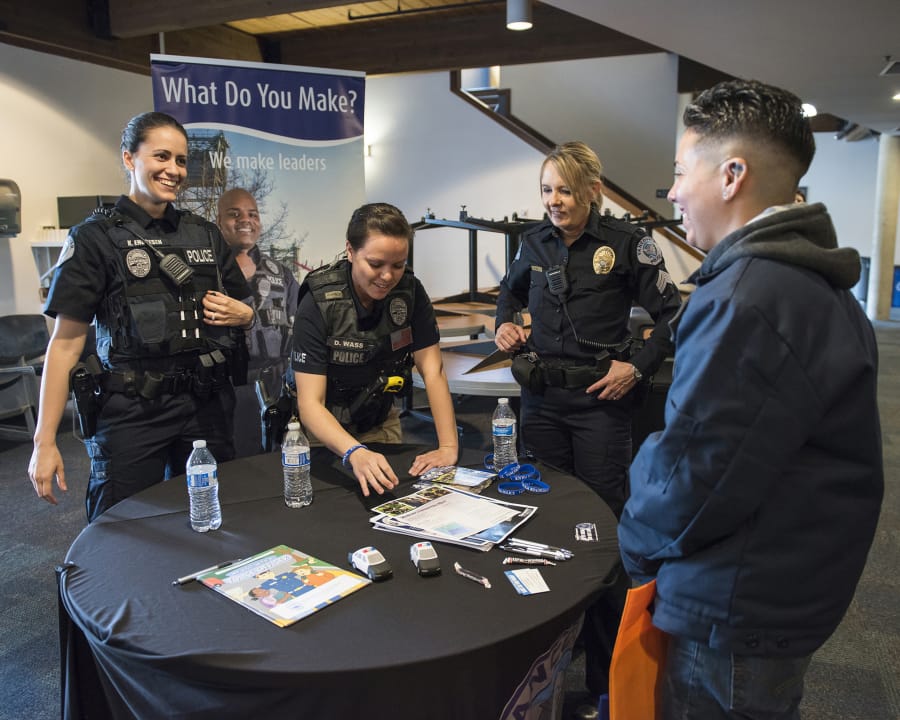From the point of hire, it takes about 19 months to get a new police officer working on the street.
That means if Vancouver Police Chief James McElvain wants to grow the force in 2020, he needs to start the hiring process in 2018. This delay is what McElvain refers to as the pipeline. He’s received city council approval to add an additional 28 officers between now and 2020, but the process isn’t as simple as some might expect.
It takes four months to complete the hiring process, which includes background checks and a polygraph exam. Then recruits wait an average of six months to go to the training academy, a process itself that lasts five months. Four more months of field training and a new hire can get to work.
Meanwhile, they’re considered part of the force and receive a paycheck as soon as the hiring process is complete. For more than a year, new hires are paid before they actually start their jobs. McElvain said they can help out with some things that don’t require academy training, like processing property evidence, but the system is held up by the academy.
“Unless the state Legislature funds the academy to put on more academy classes, the entire state law enforcement, police, sheriffs are all held hostage to get people into the academy,” McElvain said.
The state academy is the only option for Washington police to receive mandatory training. But departments can’t hold spots in the academy, which means candidates are hired months before they can receive training just to ensure a place in line.
“Because of the system being so competitive to hire quality people, if I say, ‘Hey I’m not going to hire you for a couple months,’ some other agency will say we’ll hire you,” he said.
Doing the math
Striking a balance between the number of authorized positions, overhiring to fill the processing pipeline, and planning for retirements is complex, McElvain explained. He plans to go over the process before council Monday evening.
For example, in 2016 the VPD was authorized for 190 positions. But the department was allowed to overhire by six positions. In 2017, the department’s authorization went up to 198 and then 208. Now VPD can hire up to 218 positions.
McElvain said they have 208 filled, four of which are conditional offers. He’s planning to hire 10 new officers this year, eight in 2019, six more in 2020 and then two or three annually to keep up with population increases.
To further complicate matters, at this moment 48 employees could retire at any time.
“Between now and 2025, minimally 102 people could retire,” McElvain said. “This is the bubble that we’ll carry forward year after year. I can logically project out that on average we have this many people that retire, but what we have is a little more of that occurring.”
The only way to stay ahead is overhiring.
“But the problem with overhiring is once I have overhired positions and I’m running with those positions, I absolutely need the funding behind it,” he added.
When the city council approves a higher number of positions than the department has filled, it increases the budget, and McElvain said he uses the additional funding to keep the department running until more bodies are on the street.
“Every day, every shift we run with minimum staffing,” he said. “To reach minimum staffing, it’s done through overtime.”
That’s one of the reasons McElvain went to the council in 2016 asking for additional funding. The council approved a package of tax hikes to add a total of 61 new positions to the department by 2020.
Finding a replacement for that funding package — the package relied on a business license surcharge and a multifamily per-unit fee — is the first charge of Vancouver Strong, a community advisory committee tasked with developing a sustainable funding plan for the city.
The group recently developed a funding proposal for VPD. In lieu of the housing fee, police would receive funding through increased utility taxes and an expanded business license surcharge.
Recruitment
This year, there have been more than 360 applicants to join the VPD. Only 18 of those were ultimately hired, McElvain said. In some respects, the national climate has dampened society’s desire to join the police force.
“It’s not uncommon that you will talk to somebody about coming into law enforcement and they’ll say my family wouldn’t support that,” McElvain said. “Who wants to be a police officer today? That’s the national level of conversation that seeps into the local level.”
Traditional career fairs aren’t as successful as they used to be, so the department is branching out. VPD recently placed an ad with an online publication, PoliceOne. McElvain said in the last three months they’ve received thousands of clicks and numerous applications for lateral hires. A lateral hire is someone with previous law enforcement experience which reduces the length of time needed at the academy and streamlines the process.
Some departments are moving to hiring incentives.
“We’re considering what does that look like for us,” he said.
At the same time, the department is trying to navigate diverse hiring. The promotional flyer features a diverse group of officers in an attempt to show the public the department has some diversity.
“But also to show that policing isn’t just doing SWAT activity,” he added. “That’s appealing to a certain market … but I would guess the lion’s share of our population does not imagine themselves rappelling from the side of a building, but they do see themselves interfacing with the community.”
He also wants to appeal to more women. Of the 205 officers on staff in 2017, only 27 were female.
“Can we provide an avenue that invites women in to shoot a gun? Have an opportunity to go out to the range and hold a firearm, learn a little bit about firearms and see that I can do this?” McElvain said.
The law enforcement profession has never been wanting for white, male applicants.
“They just come,” McElvain said. “But how do we appeal to the Latinos in our community, the African Americans in our community, how do we appeal to women in our community that law enforcement is a great profession that you don’t have to have some superhuman strength to do?”




